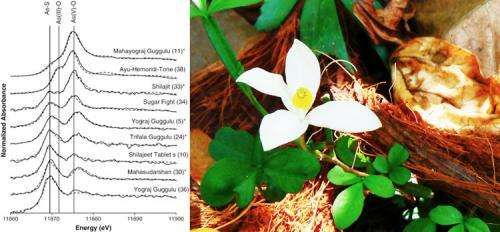Health: Two sides of traditional medicines

Traditional remedies have always been controversial — lauded by their users and scrutinized by science. The CLS synchrotron lately has been the tool of choice to study these preparations for Dr. Kenneth Reimer, a professor at the Royal Military College of Canada and co-chair of the Bioaccessibility Research Canada. Reimer and his team have recently taken to examining traditional Indian Ayurvedic medicine to understand the bioaccessibility of the ingredients used in them. The remedies often consist of gemstones, plant and animal materials, and elementsof concern such as arsenic and lead.
Traditional medicines are of interest as they are still widely used in their home countries and can be freely purchased via the internet by both immigrant communities and the general public elsewhere. The two major elements of interest for Reimer were lead and arsenic. Using synchrotron light, the chemical states of arsenic were determined in a variety of traditional Indian remedies.
The findings are noteworthy since many of the recommended doses of these medicines containing arsenic that surpass the levels that are considered safe by the Environmental Protection Agency, Food and Drug Administration and Health Canada.
“It is a personal choice to ingest whatever you want to, but it would be nice for more people to be aware of this,” Reimer notes. “But we have to ask the question, how soluble is this material and what chemical form is it in? If you have 20 parts per million of arsenic or lead, it doesn’t mean anything if you ingest it and it simply passes through your body without entering your blood stream.”
Understanding the solubility of the many forms of arsenic is important since the more readily something can be dissolved in the gastrointestinal juices of the stomach and intestine (that is, become bioaccessible) the more easily it can be absorbed into the body. Forms that are lower on the bioaccessibility scale simply pass through the body without causing harm. “We want to understand what drives that solubility… looking at arsenic in different types of chemicals including medicine can be used to better understand the chemical forms of arsenic that appear in the environment. Here, what we were mainly interested in were its nearest [atomic] neighbours: is arsenic bound to sulphur, or is it bound to oxygen? And what are the main compositions and does it relate in any way to their bioaccessibility,” explains Reimer.
Reimer was able to identify that the common chemical forms found in the medicines were arsenic oxides and arsenic bound to sulphur. By replicating the human digestive system’s chemical environment, he was able to determine that arsenic oxides were the more soluble forms, while arsenic-sulphur compounds tend to journey through the body without being absorbed. That finding is significant as the preparation of these medicines typically involve heating (and thus oxidizing) the metals such as arsenic in the belief that it will purify it, removing the unwanted traits while maintaining the beneficial qualities.
“Most methods involve a roasting or heating process. For arsenic for example, the less soluble forms are arsenic-sulphur compounds, and if you heat them in air, you almost certainly make arsenic-oxygen bonded compounds which are almost always more soluble. Therefore you would go from a form that is less toxic to one that is more toxic,” explains Reimer.
With the completion of his work with Indian medicines and still faced with a vast inventory of compounds to investigate, Reimer plans to further study traditional medicines. For Reimer, the research is not to dissuade using these concoctions but to provide knowledge — the users should understand the potential risks on top of the benefits.
“Medicines of all kinds have their pros and cons. We are arguing that you may make a better choice if you have some idea of what they contain and what potential risks there might be,” says Reimer.
More information: Koch, I., Moriarty, M., House, K., Sui, J., Saper, R., & Reimer, K. (2011) Bioaccessibility of Lead and Arsenic in Traditional Indian Medicines. Science of the Total Environment, DOI:10.1016/j.scitotenv.2011.07.059
Journal information: Science of the Total Environment
Provided by Canadian Light Source


















